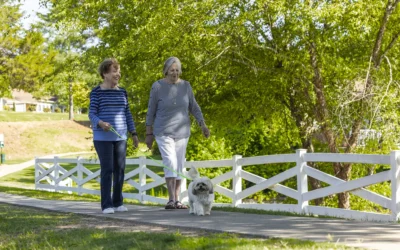‘In sickness and in health’ — but what if just one spouse needs care?
Assisted living and health care options for couples with different needs
 It’s an obvious reality that everyone ages. But no one ages at exactly the same rate. A married couple may both be 80 years old, but while one spouse may be healthy in mind and body, the other spouse has a medical issue that now requires a higher level of care.
It’s an obvious reality that everyone ages. But no one ages at exactly the same rate. A married couple may both be 80 years old, but while one spouse may be healthy in mind and body, the other spouse has a medical issue that now requires a higher level of care.
One couple, two different sets of needs. If you’re facing this situation, you have many options. Understanding those options – and deciding which one is the best fit – could have a significant impact on your and your spouse’s overall health and happiness.
Rolling Green Village in Greenville, SC. can give you greater flexibility and security in the years ahead, visit our Health Services page to explore our full continuum of care.
You could care for your spouse in your home.
Many committed partners opt to stay in their homes, with the healthy spouse becoming the caregiver for the less healthy one. Certainly, married couples often consider it their loving duty to care for one another: Part of the marriage vow is “to have and to hold, in sickness and in health.” Becoming a spouse’s caregiver may also seem like a more affordable choice, until you consider the physical and emotional toll it often places on the healthy spouse.
Many times, when the healthier spouse shoulders some or all of the burden of care, the caregiver’s emotional and physical health will start to fail. For example, the healthier spouse may fall or hurt themselves trying to lift their partner. Or the emotional stress may lead to their own decline in health.
Caring for an ill spouse can also be isolating if you have little support from family and friends. And if you no longer drive, it becomes logistically difficult to run errands or take your spouse to doctors’ appointments.
Hire a form of home care.
There’s a reason airlines instruct you to put on your oxygen mask first, before helping others. It’s a fitting metaphor: You must take care of yourself first before you can meet others’ needs. One way to care for yourself and your spouse is to bring in outside care. This may actually be the least disruptive option for a couple.
If you’re considering this option, there are two types to choose from: Home health and home care.
Home health:
- Medical care provided by an RN, OT, PT or other skilled medical professional
- Usually prescribed as part of a care plan following hospitalization
- Designed to ease that transition from hospital to home
- Services include wound care, therapy and skilled nursing, medication or injection administration
Because home care is considered medical care, it’s usually covered by Medicaid or Medicare when prescribed by a doctor. Some forms of private health insurance may also pay for home health. But most often, home health is paid for out of pocket.
Home care:
- Care provided by a home health aide
- Considered unskilled or nonclinical “personal care” or “companion care”
- Aides help with activities of daily living (ADLs) and provide companionship
- Services include meal preparation, housekeeping, and help with bathing, dressing or grooming
Generally, home care may be paid for through a long-term care insurance policy, if it’s specified in your policy. But it’s usually paid for out of pocket.
Assistance from home care and home health may alleviate some of the caregiver’s stress, but there may still be feelings of isolation. It may be difficult – if not impossible – for both spouses to have their social needs met. And as the ill spouse’s needs increase, round-the-clock care can get very expensive.
That was the situation David Burns found himself in. His wife, Barbara, had Alzheimer’s and needed more care than he could provide in their home. So in 2014, he decided to explore his senior living options.
Assisted Living Communities: A solution for seniors who need a helping hand with day-to-day activities.
When a spouse needs more help than you’re able to give, an assisted living community can provide a safer, healthier solution. Residents generally have their own apartment and benefit from a personal care plan that includes assistance with “activities of daily living.” These include medication monitoring and help with bathing, dressing, toileting and mobility. In addition to personalized care, meals, laundry, scheduled transportation and life enrichment programs are included.
A 2016 Family Quality of Life Survey found that 73% of families reported improvement in their love one’s quality of life after moving into assisted living. Residents themselves said their nutrition, social well-being and physical health all improved.
For couples with different needs, assisted living can be a good solution for seniors who don’t require nursing care. Couples can live together if they choose to in their assisted living residence, but if their health needs change, they’ll have to look elsewhere for skilled nursing or memory care.
Life Plan Communities: A solution that fits needs now and in the future.
A Life Plan Community, also known as a continuing care retirement community (CCRC), offers a full continuum of care. Independent living, assisted living, memory care and skilled nursing are all available on the same campus, and sometimes, in the same building if the community is located in a high-rise. It’s a solution that offers peace of mind because your future health needs can be met on campus without having to relocate. If one spouse needs to move to a higher level of care, he or she can make the transition with the support of people in the community they know and trust.
Couples may be separated if one spouse requires memory care or long-term skilled nursing, but they’ll be on the same campus where they can spend time together every day. It’s never easy to be separated, but couples who move to a Life Plan Community find it preferable to living in two different locations, often miles apart. At a Life Plan Community, you can remain a part of your loved one’s life. What’s more, you’ll have the support of friends and neighbors, plus opportunities to participate in activities and programs designed to enhance your quality of life.
This was the option David Burns decided was the best choice for him and his wife, Barbara. David chose a patio home on the Rolling Green Village campus because it kept him close enough to visit Barbara daily in the memory care neighborhood. His patio home also gave him plenty of space to garden, something he enjoyed at his previous home.
“I’ve been totally satisfied with it. It’s home,” says David. He was able to spend most of his days with Barbara, who enjoyed music, choir services and soaking up the sun in the courtyard. David is happy with his decision to move to Rolling Green Village. “I love the care they gave her. The people here are just super.”
Learn more about our Life Plan Community.
To learn how Rolling Green Village in Greenville, SC. can give you greater flexibility and security in the years ahead, visit our Health Services page to explore our full continuum of care. Of course, there’s much more to living at Rolling Green Village than having a smart plan in place for your health. If you’d like to discuss your options or learn more about our friendly, vibrant community, contact us or call 864-987-9800.


